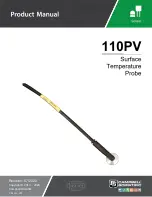
5
Bypass Controller Inputs and Outputs —
The by-
pass controller inputs and outputs are shown in Tables 1
and 2.
Table 1 — Bypass Controller Inputs
Table 2 — Bypass Controller Outputs
Install Duct Temperature Sensor —
The duct tem-
perature sensor is required. The duct temperature sensor must
be installed in the supply air duct. The 33ZCSENDAT is the
recommended sensor. See Fig. 5 for sensor details.
For bypass systems, the duct temperature sensor should be
moved to a location which will provide the best sensing of the
supply-air temperature during heating and cooling.
For bypass systems using a ducted supply, the duct tempera-
ture sensor should be located in the main supply duct
downstream of the discharge of the air source and before the
bypass damper to allow good mixing of the supply airstream.
The 33ZCSENDAT duct sensor is a small epoxy sensor that
is 1
1
/
4
-in. long. A grommet is provided for filling the hole
around the sensor cable after the sensor is located in the duct.
See Fig. 3 and 6 for mounting location.
Do not run sensor or relay wires in the same conduit or race-
way with Class 1 AC service wiring. Do not abrade, cut, or
nick the outer jacket of the cable. Do not pull or draw cable
with a force that may harm the physical or electrical properties.
Avoid splices in any control wiring.
Perform the following steps to connect the duct temperature
sensor to the bypass controller:
1. Drill or punch a
1
/
4
-in. hole in the supply duct. See
Fig. 6. Duct sensor can be installed to hang from top of
duct or from the sides. Sensor probe can touch side of
duct.
2. Push sensor through hole in the supply duct. Snap the
grommet into the hole until it is secure. Pull on the leads
of the duct sensor until the sensor is snug against the
grommet.
3. Connect the sensor leads to the bypass controller’s termi-
nal board at the terminals labeled DAT (J4-10) and GND
(J4-12). See Fig. 4 for wiring. If extending cable length
beyond 8 ft, use plenum rated, 20 AWG (American Wire
Gage), twisted pair wire. Sensor wiring does not have
polarity. Either lead can be wired to either terminal.
4. Neatly bundle and secure excess wire.
5. Using electrical tape, insulate any exposed lead to prevent
shorting.
6. Connect shield to earth ground (if shielded wire is used).
Install Pressure Tubing —
The static pressure pick up
should be located in the main supply duct before the first
branching of ductwork. Run the tubing from the bypass con-
troller to the installation location. For stable airflow measure-
ment, the recommended minimum length of tubing is 2 ft.
Connect the tubing to the high side of the pressure sensor
marked P1. Make sure the low side of the pressure sensor (P2)
is open to the atmosphere. See Fig. 3.
CHANNEL
J4 TERMINATIONS
DESCRIPTION
CONTROL
DEVICE
DUCT_TMP
10, 12
Duct Temperature
10K Thermistor
DMP_POS
9 (10 v), 7 (W+), 5 (–)
Damper Position
0-10 VDC
SP_SENSR
3, 1
System Pressure
0-5 VDC
CHANNEL
J5 TERMINATIONS
DESCRIPTION
CONTROL
DEVICE
DMPR_CCW
1 (24 VAC), 2
Damper CCW
24 VAC
DMPR_CW
3 (24 VAC), 2
Damper CW
24 VAC
Disconnect electrical power before wiring the bypass con-
troller. Electrical shock, personal injury, or damage to the
fan coil controller can result.
.225/ .245
(5.72/6.22)
75.0
.5
(1905)
1.00
(25.4)
1.25
(31.8)
0.06
(1.5)
Fig. 5 — 33ZCSENDAT Duct Sensor
NOTE: Dimensions are in inches.
Dimensions in ( ) are in mm.
DRILL 1/4" HOLE
IN TOP OF DUCT
AND LET SENSOR
HANG DOWN
ALTERNATE INSTALLATION
LOCATION INSIDE OF DUCT
SUPPLY DUCT
Fig. 6 — DAT Installation Location
Содержание VVT 33ZC
Страница 3: ...3 Fig 2 Bypass Controller Dimensions Fig 1 Bypass Controller Details...
Страница 7: ...7 Fig 7 High Torque Actuator Wiring...
Страница 8: ...8 Fig 8 High Torque Actuator with Linked Dampers Wiring...
Страница 9: ...9 Fig 9 Field Supplied Linked Damper Wiring...
Страница 10: ...10 Fig 10 Multiple Field Supplied Linked Damper Wiring...






































